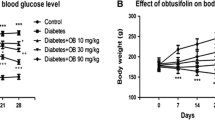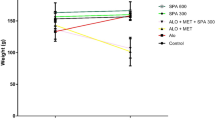Abstract
In this study, we have investigated the effect of the nutritive phytochemicals, indole-3-carbinol (I3C) and its metabolite, 3, 3′- diindolylmethane (DIM) on oxidative stress developed in type 2 diabetes mellitus (T2DM). This work was carried out in the genetically modified mouse (C57BL/6J mice) that closely simulated the metabolic abnormalities of the human disease after the administration of high fat diet (HFD). Glucose, insulin, hemoglobin (Hb), glycated hemoglobin (HbA1c), thiobarbituric acid reactive substances (TBARS), lipid hydroperoxides (LOOH), conjugated dienes (CD), superoxide dismutase (SOD), catalase (CAT), glutathione peroxidase (GPx), vitamin C, vitamin E, and reduced glutathione (GSH) levels were monitored in all the groups. Treatments positively modulate the glucose, insulin, and Hb and HbA1c levels in HFD mice. TBARS, LOOH, and CD were decreased in treatment groups when compared to the HFD group. Treatments increase SOD, CAT, GPx levels (erythrocyte, liver, kidney, and heart) and vitamin C, vitamin E, and GSH levels (plasma, liver, kidney, and heart) in diabetic mice. From the study, it was clear that the antioxidant-scavenging action were accelerated in mice treated with DIM than the I3C treatment group which was comparable with the standard drug metformin.




Similar content being viewed by others
References
Aggarwal BB, Ichikawa H (2005) Molecular targets and anticancer potential of indole-3-carbinol and its derivatives. Cell Cycle 4:1201–1215
Arnao MB, Sanchez-Bravo J, Acosta M (1996) Indole-3-carbinol as a scavenger of free radicals. Biochem Mol Biol Int 39:1125–1134
Baker H, Frank O, De Angelis B, Feingold S (1980) Plasma tocopherol in man at various times after ingesting free or acetylated tocopherol. Nutr Res 21:531–536
Biesalski HK, Vadivel V (2011) Contribution of phenolic compounds to the antioxidant potential and type II diabetes related enzyme inhibition properties of Pongamia pinnata L. Pierre seeds. Process Biochem 46:1973–1980
Blum J, Fridovich I (1985) Inactivation of glutathione peroxidase by superoxide dismutase radical. Arch Biochem Biophys 240:500–508
Bonnefont-Rousselot D, Raji B, Walrand S, Gardes-Albert M, Jore D, Legrand A (2003) An intracellular modulation of free radical production could contribute to the beneficial effects of metformin towards oxidative stress. Metabolism 52:586–589
Burgi W, Briner M, Franken N, Kessler ACH (1988) One step sandwich enzyme immunoassay for insulin using monoclonal antibodies. Clin Biochem 21:311–314
Butterfeild JD, Mc Graw CP (1978) Free radical pathology. Stroke 9:443
Ceriello A (2000) Oxidative stress and glycemic regulation. Metabolism 49:27–29
Chang HP, Wang ML, Hsu CY, Liu ME, Chan MH, Chen YH (2011) Suppression of inflammation-associated factors by indole-3-carbinol in mice fed high-fat diets and in isolated, co-cultured macrophages and adipocytes. Int J Obes 3:1530–1538
Chanwitheesuk A, Teerawutgulrag N, Rakariyatham (2005) Screening of antioxidant activity and antioxidant compounds of some edible plants of Thailand. Food Chem 92:491–497
De Kruif CA, Marsman JW, Venekamp JC, Falke HE, Noordhoek J, Blaauboer BJ, Wortelboer HM (1991) Structure elucidation of acid reaction products of indole-3-carbinol: detection in vivo and enzyme induction in vitro. Chem Biol Interact 80:303–315
Drabkin DL, Austin JM (1932) Spectrophotometric constants for common haemoglobin derivatives in human, dog and rabbit blood. J Biol Chem 98:719–733
Dunn SE, Leblanc GA (1994) Hypocholesterolemic properties of plant indoles: inhibition of acyl-coa: cholesterol acyltransferase activity and reduction of serum LDL/VLDL cholesterol levels by glucobrassicin derivatives. Biochem Pharmacol 41:359–364
Ellman GL (1959) Tissue sulfhydryl groups. Arch Biochem Biophys 82:70–77
Evans JL, Goldfine ID, Maddux BA, Grodsky GM (2002) Oxidative stress and stress-activated signaling pathways: a unifying hypothesis of type 2 diabetes. Endocr Rev 23:599–622
Geoffrey KM, Joan EK, Adele C, Andre GT (2007) Cruciferous indole-3-carbinol inhibits apolipoprotein B secretion in HepG2 cells1–3. J Nutr 137:2185–2189
Gregus Z, Fekete T, Halaszi E, Klaassen CD (1996) Lipoic acid impairs glycine conjugation of benzoic acid and renal excretion of benzoylglycine. Drug Metab Dispos 24:682–688
Habig WH, Pabst MJ, Jakoby WBC (1974) Glutathione-S-transferases: the first enzymatic step in mercapturic acid formation. J Biol Chem 249:7130–7139
Jiang ZY, Hunt JV, Wolff SP (1992) Ferrous ion oxidation in the presence of xylenol orange for the detection of lipid hydroperoxides in low density lipoprotein. Anal Biochem 202:384–389
Kakkar P, Das B, Viswanathan PN (1984) A modified spectrophotometric assay of superoxide dismutase. Indian J Biochem Biophys 21:130–132
Kesavulu MM, Giri R, Kameswara Rao B, Apparao C (2000) Lipid peroxidation and antioxidant enzyme levels in type 2 diabetics with microvascular complications. Diabetes Metab 26:387–392
Kim HW, Kim J, Kim J, Lee S, Choi BR, Han JS, Lee KW, Lee HJ (2014) 3,3′Diindolylmethane inhibits lipopolysaccharide-induced microglial hyperactivation and attenuates brain inflammation. Toxicol Sci 137:158–167
Kim YS, Milner JA (2005) Targets for indole-3-carbinol in cancer prevention. J Nutr Biochem 16:65–73
Lampe JW (1999) Health effects of vegetables and fruit: assessing mechanisms of action in human experimental studies. Am J Clin Nutr 70:475–490
Li W, Zhang M, Gu J, Meng ZJ, Zhao LC, Zheng YN, Chen L, Yang GL (2012) Hypoglycemic effect of protopanaxadiol-type ginsenosides and compound K on type 2 diabetes mice induced by high-fat diet combining with streptozotocin via suppression of hepatic gluconeogenesis. Fitoterapia 83:192–198
Lowry OH, Roseborough NJ, Farr AL, Randall RJ (1951) Protein measurement with Folin’s phenol reagent. J Biol Chem 193:265–275
Mark JA, Margaret MM, Richard V, Andreas G, William PS, Marion LW, Donald EM (2004) Physiological modeling of formulated and crystalline 3,3-diindolylmethane pharmacokinetics following oral administration in mice. Drug Metab Dispos 32:632–638
Niehaus WG, Samuelsson B (1968) Formation of malondialdehyde from phospholipid arachidonate during microsomal lipid peroxidation. Eur J Biochem 6:126–130
Niskanen LK, Salonen JT, Nyssonen K, Uusitupa MIJ (1995) Plasma lipid peroxidation and hyperglycemia: a connection through hyperinsulinaemia? Diabet Med 12:802–808
Rao KS, Recknagel RO (1968) Early onset of lipoperoxidation in rat liver after carbon tetrachloride administration. Exp Mol Pathol 9:271–278
Roe JH, Kuether CA (1943) The determination of ascorbic acid in whole blood and urine through the 2, 4-dinitrophenylhydrazine derivative of dehydroascorbic acid. J Biol Chem 11:145–164
Rogan EG (2006) The natural chemopreventive compound indole-3-carbinol: state of the science. In Vivo 20:221–228
Rotruck JT, Pope AL, Ganther HE, Swanson AB, Hafeman DG, Hoekstra WG (1973) Selenium: biochemical role as a component of glutathione peroxidase. Science 179:588–590
Sepkovic DW, Bradlow HL, Bell M (2001) Quantitative determination of 3,3 -diindolylmethane in urine of individuals receiving indole-3-carbinol. Nutr Cancer 41:57–63
Sharpe PC, Liu W-H, Yue KK, McMaster D, Catherwood MA, McGinty AM, Trimble ER (1998) Glucose induced oxidative stress in vascular contractile cells. Diabetes 47:801–809
Sinha AK (1972) Colorimetric assay of catalase. Anal Biochem 47:389–394
Staub RE, Feng C, Onisko B, Bailey GS, Firestone GL, Bjeldanes LF (2002) Fate of indole-3-carbinol in cultured human breast tumor cells. Chem Res Toxicol 15:101–109
Sudhakar NS, Pattabiraman TN (1981) A new colorimetric method for the estimation of glycosylated haemoglobin. Clin Chim Acta 109:267–274
Sundaresan A, Pugalendi KV (2012) Combined effect of ursolic acid and rosiglitazone on redox status in high fat diet induced C57BL/6J mice. J Pharm Res 5:2380–2384
Weng J-R, Tsai C-H, Kulp SK, Che C-S (2008) Indole-3-carbinol as a chemopreventive and anti-cancer agent. Cancer Lett 262:153–163
Zimmet P (2003) The burden of type 2 diabetes: are we doing enough? Diabetes Metab 29:9–18
Author information
Authors and Affiliations
Corresponding author
Rights and permissions
About this article
Cite this article
Jayakumar, P., Pugalendi, K.V. & Sankaran, M. Attenuation of hyperglycemia-mediated oxidative stress by indole-3-carbinol and its metabolite 3, 3′- diindolylmethane in C57BL/6J mice. J Physiol Biochem 70, 525–534 (2014). https://doi.org/10.1007/s13105-014-0332-5
Received:
Accepted:
Published:
Issue Date:
DOI: https://doi.org/10.1007/s13105-014-0332-5




